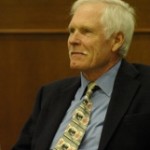Sep20
Large-scale Solutions without Large-scale Organizations – #BIF6
Point: Instead of trying to change large organizations, we can create new human-scale organizations that embody the needed changes and inspire passion. Micro-volunteering site Sparked.org, citizen site SeeClickFix and Fabien Cousteau’s PlantaFish point the way.
Story: What makes you want to get out of bed in up morning? Inventure Group founder Richard Leider has been asking people this question for over 40 years. The crosscutting answer: purpose. Even better, Leider has found that people with a sense purpose live longer.
Contrast this with John Hagel‘s data that only 20% of US workers feel passionate about their jobs. And the larger the organization, the lower the passion. That lack of passion does not bode well for either these workers or their organizations.
At the Business Innovation Factory‘s BIF-6 summit, 37Signals co-founder Jason Fried posed a similarly fundamental question about organizational growth. Fried asked, “Should we grow?” His answer: “maybe not,” because so many larger organizations struggle with inertia, bureaucracy, and passion-killing processes. Fried recommended having human-scale organizations of no more that $10 million in revenues.
So how can we keep passion and purpose yet still effect the large-scale changes we need to solve global societal problems like healthcare, climate change and ineffective education systems?
Two BIF-6 storytellers illustrated web 2.0 systems that enable small informal actions by large numbers of people to augment or supplant the activities of larger organizations. First, Extraordinaries founder Jacob Colker described www.sparked.org , which is platform for micro-volunteering. The system lets qualified organizations (such as a Kenyan village working to bring clean water to its citizens) post requests for simple, low-commitment, high-skill tasks (such as marketing recommendations, tech support, etc.). Anyone can volunteer their professional services in quick 5-20 minute increments — volunteering while waiting in line, for example.
Second, Ben Berkowitz described his SeeClickFix.com site, which lets citizens report small problems in their communities to a single site. The site routes alerts of these problems to appropriate civic authorities and elected officials.
Both examples illustrate two key points about the future. First is the power of engaging informal, ad hoc participants. Rather than building a lumbering command-and-control workforce, these new systems rely on the billions of hours of idle cognitive and labor resources lying fallow in our communities. Second, these two examples illustrate the power of web 2.0 tools to create large-scale solutions without large-scale development efforts. Anyone with an idea, passion, and a modicum of technical expertise can build an online system that scales to millions or billions of users. Behemoth organizations are neither necessary nor sufficient to solve tomorrow’s problems.
Fabien Cousteau, grandson of oceanographer Jacques Cousteau and founder of Plant A Fish, provided compelling motivation for large-scale change: saving the planet takes precedence over saving any organization. Rather than reform old large organizations, we can create new human-scale organizations that embody the needed changes and inspire passion.
Action
- Don’t assume that large, mature, centralized organizations can or should change
- Look for solutions that solve a problem through millions of small steps (handled by distributed crowds)
- Use lightweight online systems rather than heavyweight organizations to inform, engage, and mobilize far-flung participants/activists
- Invest in building the young and dynamic rather than changing the old and static.
For more information:
John Hagel’s website, Center for the Edge at Deloitte and new book, The Power of Pull
Comments Off on Large-scale Solutions without Large-scale Organizations – #BIF6Case study, Entrepreneurs, How-to, Innovation, Software tool











